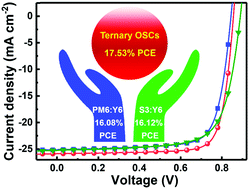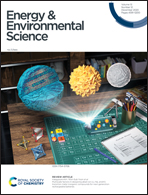Two compatible polymer donors contribute synergistically for ternary organic solar cells with 17.53% efficiency†
Abstract
A ternary strategy has been demonstrated as a promising method to further boost the performance of organic solar cells (OSCs). Herein, an efficient polymer donor S3 was synthesized and incorporated into a PM6:Y6 system to fabricate ternary OSCs. S3 possesses complementary absorption spectra and good compatibility with PM6, which is beneficial to fine-tune the photon harvesting and morphology of the ternary blend films, resulting in simultaneous enhancement of the short-circuit current density (JSC) and fill factor (FF). In addition, the highest occupied molecular orbital (HOMO) energy level of S3 is slightly lower than that of PM6, which enables lower nonradiative energy loss in ternary OSCs compared with that of PM6-based binary OSCs, leading to higher open-circuit voltage (VOC). The optimized ternary OSCs with 20 wt% S3 in the donors achieve a PCE of 17.53%, which should be among the highest values of ternary OSCs. This work provides an effective approach to fabricate high-performance ternary OSCs by synergizing two well-matched polymer donors.



 Please wait while we load your content...
Please wait while we load your content...